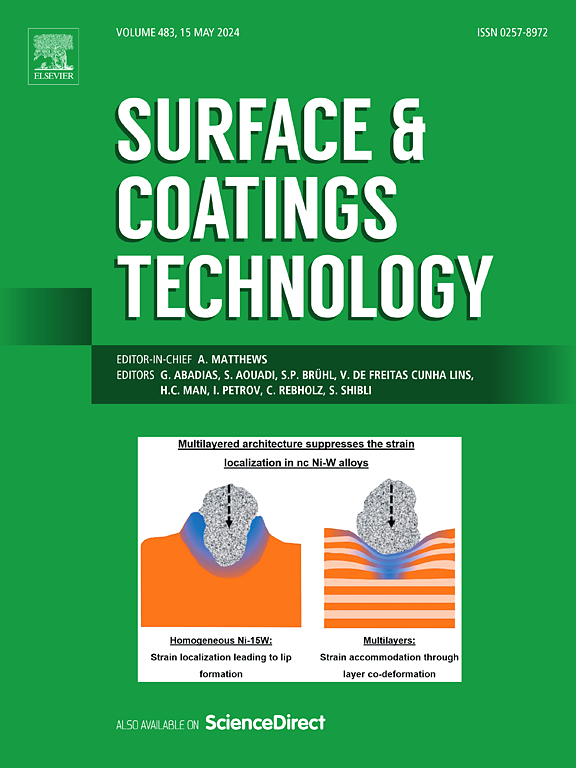ZrO2-YTaO4热障材料1250℃抗CMAS腐蚀性能研究
IF 5.3
2区 材料科学
Q1 MATERIALS SCIENCE, COATINGS & FILMS
引用次数: 0
摘要
相变不稳定性和腐蚀失效是热障涂层在高温和CaO-MgO-Al2O3-SiO2 (CMAS)环境下降解的两种主要形式。钽材料的加入可有效提高钇稳定氧化锆(YSZ) TBC的相稳定性。但是,钽材料对涂层耐腐蚀性能的影响以及涂层抗CMAS的机理还需要进行详细的分析。对新型ZrO2-YTaO4材料的CMAS腐蚀行为及其抗CMAS腐蚀机理进行了一系列研究。为了获得综合性能优异、抗CMAS的TBC复合材料,对样品的力学性能进行了讨论。结果表明,与YSZ相比,ZrO2-YTaO4材料具有更好的相稳定性、力学性能和抗CMAS性能。当陶瓷基体中Ta浓度增加时,会导致Y与CMAS的反应减弱,从而抑制TBC的球化。在腐蚀界面处形成致密的Ca2Ta2O7层,阻断了CMAS在陶瓷中的渗透通道,抑制了陶瓷与熔融CMAS之间的互扩散,有效提高了耐蚀性。另一方面,由于Ca2Ta2O7层的形成导致CMAS熔液中Ca含量的降低,导致CMAS的粘度增加,阻止了CMAS进一步渗入基体。本文章由计算机程序翻译,如有差异,请以英文原文为准。
Investigation of CMAS corrosion resistance for ZrO2-YTaO4 thermal barrier material at 1250 °C
The phase transformation instability and corrosion failure are the two main forms of degradation for thermal barrier coating (TBC) in the high temperature and CaO-MgO-Al2O3-SiO2 (CMAS) environments. The addition of tantalum materials can effectively improve the phase stability of yttria-stabilized zirconia (YSZ) TBC. However, the effect of tantalum materials on the corrosion resistance performance and the mechanism of the coating against CMAS need to be analyzed in detail. A series of researches were conducted on the CMAS corrosion behavior of the novel ZrO2-YTaO4 material and the mechanism by which it resists CMAS. In order to obtain a composition with excellent comprehensive performance and CMAS resistance for TBC, the mechanical properties of the samples are discussed. The results demonstrated that, compared with YSZ, the ZrO2-YTaO4 material exhibited superior phase stability, mechanical properties and CMAS resistance property. When the Ta concentration in the ceramic matrix increases, it can lead to a reduction in the reaction between Y and CMAS, which can inhibit the spheroidisation of the TBC. Besides, a dense Ca2Ta2O7 layer forms at the corrosion interface, the infiltration channels of CMAS in the ceramic are blocked, and the inter-diffusion between the ceramic and molten CMAS is inhibited, which effectively improves the corrosion resistance. On the other hand, the reduction in the Ca content in the molten CMAS resulting from the formation of the Ca2Ta2O7 layer leads to an increase in the viscosity of the CMAS and prevents further infiltration into the matrix.
求助全文
通过发布文献求助,成功后即可免费获取论文全文。
去求助
来源期刊

Surface & Coatings Technology
工程技术-材料科学:膜
CiteScore
10.00
自引率
11.10%
发文量
921
审稿时长
19 days
期刊介绍:
Surface and Coatings Technology is an international archival journal publishing scientific papers on significant developments in surface and interface engineering to modify and improve the surface properties of materials for protection in demanding contact conditions or aggressive environments, or for enhanced functional performance. Contributions range from original scientific articles concerned with fundamental and applied aspects of research or direct applications of metallic, inorganic, organic and composite coatings, to invited reviews of current technology in specific areas. Papers submitted to this journal are expected to be in line with the following aspects in processes, and properties/performance:
A. Processes: Physical and chemical vapour deposition techniques, thermal and plasma spraying, surface modification by directed energy techniques such as ion, electron and laser beams, thermo-chemical treatment, wet chemical and electrochemical processes such as plating, sol-gel coating, anodization, plasma electrolytic oxidation, etc., but excluding painting.
B. Properties/performance: friction performance, wear resistance (e.g., abrasion, erosion, fretting, etc), corrosion and oxidation resistance, thermal protection, diffusion resistance, hydrophilicity/hydrophobicity, and properties relevant to smart materials behaviour and enhanced multifunctional performance for environmental, energy and medical applications, but excluding device aspects.
 求助内容:
求助内容: 应助结果提醒方式:
应助结果提醒方式:


